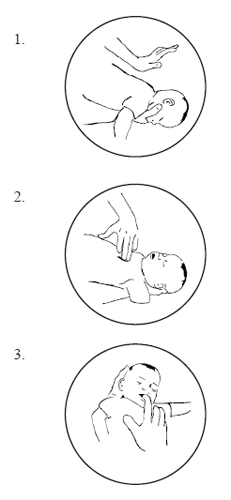Care for a Choking Infant (also called Infant Heimlich Maneuver)
| Always call 911 for a medical emergency. It is the safest and fastest way to get life-saving help. 911 call takers are trained to ask a series of important questions that usually begin with "What's your emergency?" The questions allow call takers to send the right type of help. Know that as call takers are asking questions and gathering information, they are dispatching units and sending information real time. 911 operators are trained to talk callers through giving first-aid or CPR, if necessary. If you are alone, contact 911 before administering aid. If you are not, have one person call 911 as the other gives assistance. |
Do not try the Heimlich maneuver unless you are sure the person is choking. If the person can cough or make sounds, let him or her cough to try to get the object out. If you are worried about the person's breathing, call 911.
Infants (less than one year old) should receive a combination of backslaps (back blows) and chest thrusts. The Adult and Child Heimlich Maneuver (abdominal thrusts) is not recommended for use on infants 12 months or younger.
To perform this method, follow these steps:
- Turn the infant face down with their chest resting on your forearm. Make sure their head is lower than their body.
- Using the heel of your hand, strike the infant between their shoulder blades five times. The strikes should be firm but not so hard that you cause injury.
- Check the infant’s mouth and remove any visible objects.
- If their airway remains blocked, turn the infant face up with their head down. Using two or three fingers, give five inward chest thrusts about 1 to 1½ inches into the infant’s breastbone (sternum).
- Check the infant’s mouth for visible objects again. Repeat this process until the object is freed (dislodged) or the infant becomes unconscious. If the infant becomes unconscious, start CPR.
The Heimlich Maneuver (abdominal thrusts) can be performed on children that are choking on a solid object and that cannot speak or cough forcibly. For the purposes of CPR and the Heimlich Maneuver, an infant is a child less than one year old. A child is a person that is no longer an infant but has not reached the age of puberty. The average age of puberty for boys and girls is 8 - 14 years. For a child, the Heimlich Maneuver is slightly altered. The rescuer should kneel behind the child to get down to their level. Then, they should use less forceful abdominal thrusts than the typical Heimlich Maneuver requires.
|
Determine if the infant can cry or cough.
|
 |
*This is not a complete guide to CPR or the Heimlich Maneuver for infants, children or adults. Please consider the many reasons to take training courses and get CPR certification to be confident you know how to correctly perform CPR for all ages.

